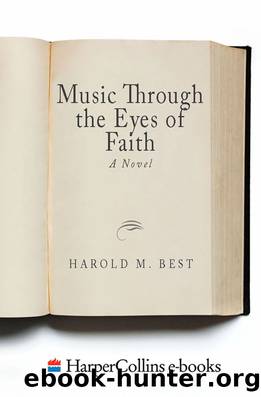Music Through the Eyes of Faith by Harold Best

Author:Harold Best
Language: eng
Format: epub
Publisher: HarperCollins
Production and Content Are Separate Aesthetic Issues
The performing arts (dance, drama, and music) differ from the other arts in that they are not complete until they are performed. This means two things. First, aside from recording technology, which freezes a single performance into a near infinity of exact replications, no two live performances will ever be exactly alike. And given the nature of Godâs way of creating, the wonder of individuated imagination and human frailty itself, this is a blessing. Godâs way of creating assures us that no two things are alike or will ever happen in the same way twice; individuated imagination means that no two individuals will ever do any one thing the same way; and human frailty is there to prompt us toward excellenceâ attempting to perform or do it better next time.
Second, it means that there are standards of quality, applying directly to performance, that are separate from the standards of quality applied to the content of the work to be performed. Hence, there is a difference between a great performance and a performance of great music. Sometimes there are great performances of great music, other times poor performances of great music, and still other times great performances of bad music. It is quite easy to confuse these, especially in a time when technique, production, and reproduction are as highly developed as they are and as important as we have made them.
It takes a long time to build up a tradition of performance excellence. This is as true of sport or craft as it is of the arts. No one will dispute the fact that, overall, there are more technically proficient performers today than ever before in the history of music making. This is both good and bad. It is good because good performance is enjoyable. As we saw in chapter 1, it is bad when the quality of the performance becomes so important that the musical content itself becomes irrelevant.3
There is an even more troublesome aspect to the overemphasis on production, having to do with applied technological paraphernalia, which can be used in any number of ways to enhance performance and manipulate content. In some respects, musical practice is all the better off for this. When used honestly and creatively, technological manipulation brings to music qualities and variegations that just a few years ago were only dreamed of.
In one area, however, its use should be seriously challenged. In popular music, Christian and secular, technological devices are often used to create a bigger/better-than-life environment and, even more questionably, to cover notoriously weak and untalented performers and to make even the very good artists appear to be more than they really are. This is nothing other than aesthetic cover-up. While the artistic content of live concerts can be manipulated to a remarkable degree, the real scam takes place in the recording studio, where events are so enhanced, sifted, shifted, corrected, and transformed that many artists and musical events can only survive on recordings. The ethical and aesthetic loss to young people especially is immeasurable.
Download
This site does not store any files on its server. We only index and link to content provided by other sites. Please contact the content providers to delete copyright contents if any and email us, we'll remove relevant links or contents immediately.
The Goal (Off-Campus #4) by Elle Kennedy(13459)
Kathy Andrews Collection by Kathy Andrews(11706)
Diary of a Player by Brad Paisley(7458)
What Does This Button Do? by Bruce Dickinson(6121)
Assassin’s Fate by Robin Hobb(6101)
Big Little Lies by Liane Moriarty(5677)
Altered Sensations by David Pantalony(5027)
Pale Blue Dot by Carl Sagan(4883)
Sticky Fingers by Joe Hagan(4083)
The Death of the Heart by Elizabeth Bowen(3530)
The Heroin Diaries by Nikki Sixx(3478)
Beneath These Shadows by Meghan March(3248)
Confessions of a Video Vixen by Karrine Steffans(3229)
How Music Works by David Byrne(3155)
The Help by Kathryn Stockett(3066)
Jam by Jam (epub)(3003)
Harry Potter 4 - Harry Potter and The Goblet of Fire by J.K.Rowling(2971)
Strange Fascination: David Bowie: The Definitive Story by David Buckley(2780)
Petty: The Biography by Warren Zanes(2681)
